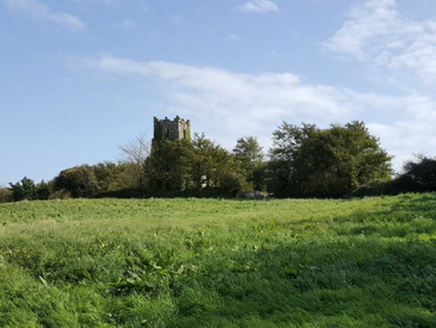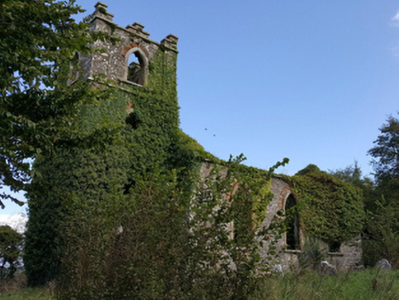Survey Data
Reg No
22904011
Rating
Regional
Categories of Special Interest
Architectural, Artistic, Historical, Social
Original Use
Church/chapel
Date
1820 - 1825
Coordinates
212021, 78335
Date Recorded
05/01/2004
Date Updated
--/--/--
Description
Detached three-bay double-height single-cell Board of First Fruits Church of Ireland church, built 1821, on a rectangular plan; single-bay three-stage tower (west) on a square plan. Closed, 1926. Now in ruins. Pitched roof now missing with no rainwater goods surviving on lichen-spotted cut-limestone eaves. Creeper- or ivy-covered coursed rubble limestone battered walls on overgrown plinth with lichen-spotted flush quoins to corners; creeper- or ivy-covered coursed rubble limestone walls (tower) on overgrown plinth with lichen-spotted cut-limestone stringcourses including lichen-spotted cut-limestone stringcourse (bell stage) supporting crow stepped battlemented parapets having lichen-spotted cut-limestone coping. Pointed-arch window openings with lichen-spotted cut-limestone sills, and cut-limestone surrounds having chamfered reveals with red brick voussoirs. Curvilinear-headed door opening (tower) with overgrown threshold, and cut-limestone surround having chamfered reveals with red brick voussoirs. Quatrefoil window openings (second stage), cut-limestone surrounds having chamfered reveals with red brick voussoirs. Pointed-arch openings (bell stage) with lichen-spotted cut-limestone sills, and cut-limestone surrounds with red brick voussoirs. Interior in ruins. Set in unkempt grounds with piers to perimeter having overgrown capping supporting looped flat iron double gates.
Appraisal
A church erected with financial support from the Board of First Fruits (fl. 1711-1833) representing an integral component of the early nineteenth-century ecclesiastical heritage of County Waterford with the architectural value of the composition suggested by such attributes as the standardised nave-with-entrance tower plan form; the "pointed" profile of the openings underpinning a contemporary Georgian Gothic theme; and the crow stepped battlements embellishing the tower as a picturesque eye-catcher in the landscape.



